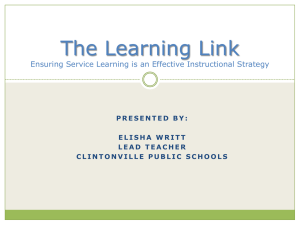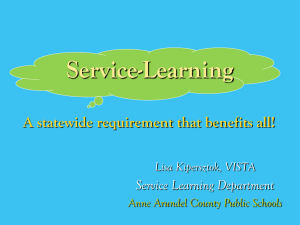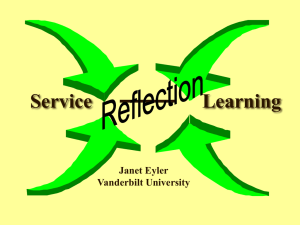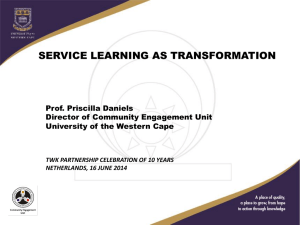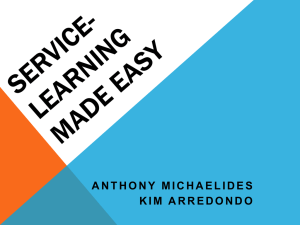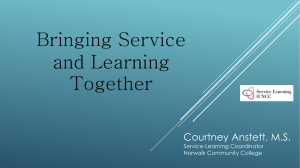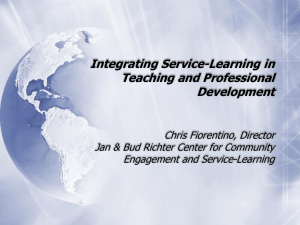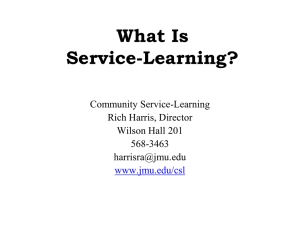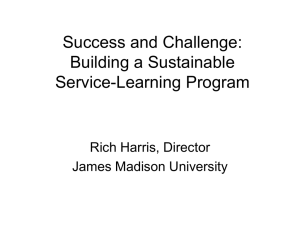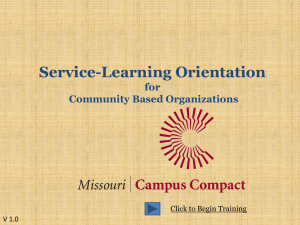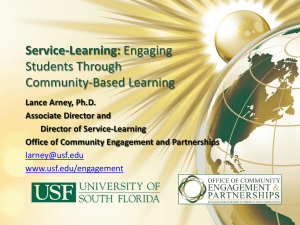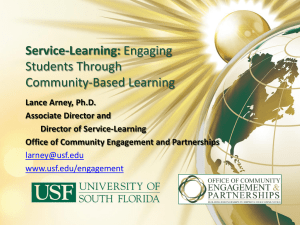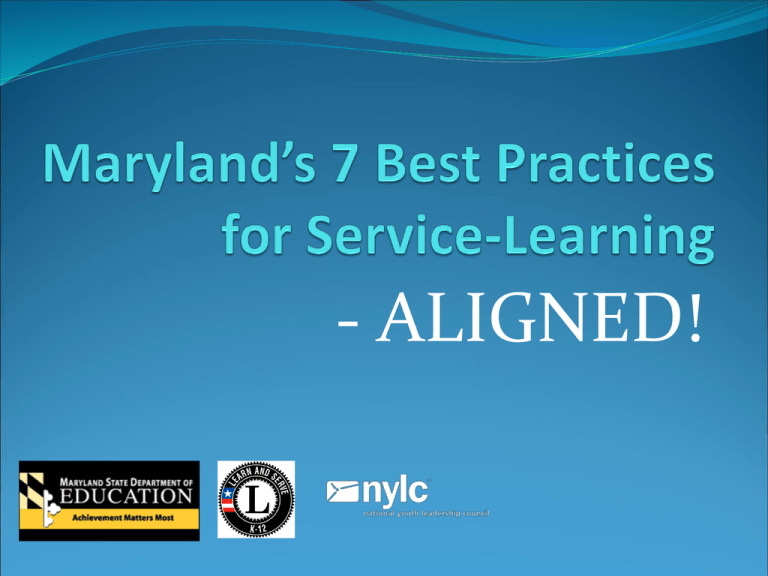
- ALIGNED!
Did you know?
In 2008, the National Youth Leadership Council
(NYLC) distributed their K-12 Service-Learning
Standards for Quality Practice.
Maryland already had their Seven Best Practices for
Service-Learning, which had been widely distributed
across Maryland since 1995.
7 Best Practice History
Initial data generated through interviews in 1994 with 70
teachers in Maryland who were doing high quality servicelearning.
Data reviewed and refined by a work group comprised of local
school system service-learning contacts, teachers, and
MSDE/Maryland Student Service Alliance staff. Draft 7 Best
Practices created.
Final review and refinement of Best Practices by a national
work group of service-learning experts.
Current 7 Best Practices published and distributed in 1995.
The 7 Best Practices are deeply embedded within all aspects of
service-learning in Maryland.
National Standards History
Work stimulated by the necessity of using credible
research to support education strategies.
Process began with a review of the Essential Elements of
Service-Learning (national project) which were developed
in the last decade. The validity of each Element was tested
using a survey of high quality service-learning research
studies.
Next, experts in the field were convened to draft the initial
set of standards.
Standards were then presented for public comment.
Fine-tuned national service-learning standards were
released and distributed in 2008.
http://www.servicelearning.org/instant_info/fact_sheets/k12_facts/standards
The question became
Service-Learning Standards –
Side by Side Comparison
Maryland’s 7 Best Practices
of Service-Learning
Meet a recognized need in the community
National Standards and Indicators for
Effective Service-Learning Practice
Meaningful Service
Achieve curricular objectives through servicelearning
Link to Curriculum
Reflect throughout the service-learning
experience
Reflection
Develop student responsibility
Diversity
Establish community partnerships
Youth Voice
Plan ahead for service-learning
Partnerships
Equip students with knowledge and skills needed
for service
Progress Monitoring
Duration and Intensity
Standard #1
Best Practice #1
Meet a recognized need
in the community
Students work to
identify pressing
community needs and
devise and participate
in projects that address
those needs.
National Standard #1
Meaningful Service
Standard: Servicelearning actively
engages participants in
meaningful and
personally relevant
service activities.
New Best Practice/Standard #1
Address a recognized need in the
community
• A community need is identified and participants
engage in meaningful and personally relevant
activities to address those needs.
• Project goals and community needs will dictate the
project’s duration and intensity.
Supporting Research
Furco (2002) found that the young people in his
California study who had the strongest outcomes were
those engaged in meaningful service activities that
challenged them, interested them, or gave them the
highest levels of responsibility.
Standard #2
Best Practice #2
Achieve curricular
objectives through
service-learning
Service-learning
provides an
opportunity for
classroom knowledge
to be applied and
tested in real-life
settings.
National Standard #2
Link to Curriculum
Standard: Servicelearning is
intentionally used as an
instructional strategy
to meet learning goals
and/or content
standards.
New Best Practice/Standard #2
Achieve curricular objectives
Service-learning is an intentional instructional
strategy used to meet existing course outcomes by
providing opportunities for classroom knowledge to
be applied and tested in real-life settings.
Supporting Research
Kirkham (2001) reported that nearly all of the teachers
who connected service-learning to their curriculum
reported that students who participated in servicelearning mastered more knowledge and skills than
they would have learned through regular instruction
and that their grades improved and absenteeism
decreased.
Standard #3
Best Practice #3
Reflect throughout the
service-learning
experience
Through reflection
activities in the form of
discussions, journaling,
performing, writing, etc.,
students come to more
fully understand the
connection of their
schoolwork to the service
work performed.
National Standard #3
Reflection
Standard: Service-learning
incorporates multiple
challenging reflection
activities that are
ongoing and that prompt
deep thinking and
analysis about oneself
and one’s relationship to
society.
New Best Practice/Standard #3
Reflect throughout the servicelearning experience
• Through a variety of challenging and on-going
reflection activities, students engage in deep thinking
and analysis about oneself, one’s relationship to
society, and how academic knowledge and skills can
be applied to help the community.
Supporting Research
In a study of high school students, Billig, Root, and
Jesse (2005) reported that the more cognitive challenge
within the reflection activities, the more likely
students were to engage in and value school, feel more
efficacious, and acquire more civic knowledge and
more positive civic dispositions. Those youth who
engaged in the greatest amount of reflection were the
most engaged in school. Waterman (1993) reported
that students who engaged in more reflection had
stronger self-confidence and social responsibility than
those who did not.
Standard #4
Best Practice #4
Develop student
responsibility
High quality servicelearning allows
students to take
leadership and
ownership over the
projects performed.
National Standard #5
Youth Voice
Standard: Servicelearning provides youth
with a strong voice in
planning,
implementing, and
evaluating servicelearning experiences
with guidance from
adults.
New Best Practice/Standard #4
Develop Student Responsibility
Students take leadership and ownership in planning,
implementing, and evaluating service-learning
experiences with age-appropriate guidance.
Supporting Research
Research demonstrates (i.e. Bradley, et al., 2007) that
students who had more ownership over the
development and presentation of their servicelearning projects had higher increases in selfconfidence, personal efficacy, interpersonal
communication, and critical thinking skills.
Standard #5
Best Practice #5
Establish community
partnerships
Service-learning
experiences provide
opportunities for
students to learn about
their communities,
explore career
possibilities, and work
with diverse groups of
individuals.
National Standard #6
Partnerships
Standard: Servicelearning partnerships
are collaborative,
mutually beneficial,
and address
community needs.
New Best Practice/Standard #5
Establish community partnerships
Service-learning experiences provide opportunities for
students to learn about their local or global
communities, explore career possibilities, and work
with diverse groups of individuals in a collaborative
and mutually beneficial way.
Supporting Research
Reciprocal partnerships were identified as critical
success factors in institutionalizing service-learning
practice by Ammon, Furco, Chi, and Middaugh (2002),
Billig (2002b), and Bailis (2000). Bailis concluded that
the most benefit would be derived in a partnership
that was long-term, well-designed, and mutually
beneficial, characterized by collaborative
communication and interaction between the
stakeholders and using efficient leveraging of
community assets.
Standard #6
Best Practice #6
Plan ahead for servicelearning
As with all effective
instruction, an action
plan must be created
which features specific
objectives to be achieved
through the activity.
National Standard #7
Progress Monitoring
Standard: Service-learning
engages participants in
an ongoing process to
assess the quality of
implementation and
progress toward meeting
specified goals, and uses
results for improvement
and sustainability.
New Best Practice/Standard #6
Plan ahead for service-learning
• With community, student, and teacher input, create
an action plan and continuously assess the progress
toward specific objectives using results for
improvement and sustainability of the project.
Supporting Research
Shumer (1997) concluded that reflection and feedback
were necessary for monitoring the flow and direction
of practice to ensure that goals were met.
Standard #7
Best Practice #7
Equip students with knowledge
and skills needed for service
To effectively engage in a project,
students must understand the
issue they will be addressing. As
part of preparing to engage in
service-learning, students are
often required to conduct
research, read articles, and listen
to guest speakers. Students also
need to learn project specific
skills, as well as explore issues
related to citizenship and civic
engagement.
National Standard # 4
Diversity
Standard: Servicelearning promotes
understanding of
diversity and mutual
respect among all
participants.
New Best Practice/Standard #7
Equip students with knowledge and
skills needed for civic engagement
• Mutual respect among all participants is established
when students fully understand the complexities of the
issue, acquire the project specific skills, and explore the
importance of civic responsibility.
Supporting Research
Some service-learning practices led to reinforcing
stereotypes and promoting the imbalance of power in
the relationship between social groups. Simmons and
Toole (2003) noted that a missionary ideology is less
likely when service planning is based on an assets
model, when participants directly address the issue of
culture, and when reflection activities ask participants
to think about the larger context of societal needs and
cultural traditions of those being served and those
providing the service.
Standard #8
Maryland has Seven Best
Practices!
Much thought was given to
creating an eighth standard
to match the National
Standards. Maryland
realized this criteria is met
through our existing
service-learning graduation
requirement of 75 hours of
student engagement.
National Standard #8
Duration and Intensity
Standard: Service-learning
has sufficient duration
and intensity to address
community needs and
meet specified outcomes.
COMAR Reg 13A.03.02.06
Our COMAR Reg is our duration and intensity
statement!
General Instructional Programs 13A.03.02.06
D. Student Service. Students shall complete one of the
following: .... (1) seventy-five hours of student service that
includes preparation, action, and reflection components
and that, at the discretion of the local school system, may
begin during the middle grades;
or
(2) a locally-designed program in student service that has
been approved by the State Superintendent of Schools.
Added Benefits of Aligning
Data, data, data!
The new national standards and corresponding data
support Maryland’s existing 7 Best Practices. The fine
tuning of Maryland’s 7 Best Practices allows us to more
closely align with the new national standards and draw
on their body of research, which validates what we’ve
believed all along Service-Learning is an effective instructional
strategy!
Links to the National Standards
Standards and Indicators for Effective Service-Learning
Practice
K-12 Service-Learning Standards for Quality Practice
The New K-12 Standards for Service-Learning:
Supporting Research and Implications for Practice (pdf)
Toward Research-Based Standards for K-12 ServiceLearning (pdf)
Unpacking What Works in Service-Learning: Promising
Research-Based Practices to Improve Student Outcomes
(pdf)
Growing to Greatness 2008 (pdf)
Links to the Research
NYLC: Service-Learning Resource Library (to all of the
articles)
Can Service-Learning Help Reduce the Achievement
Gap? (pdf)
The Generator, August 2007 (pdf)
Lessons from Research on Teaching and Learning
(pdf)
Symbiosis: When Service-Learning Meets the Work of
Howard Gardner (pdf)
Where do we go from here?
Future publications will reflect these changes and will
reference the new standards.
Pages 6-13 in the Maryland Student Service-Learning
Guidelines book will be replaced with revised materials
to reflect the new standards. Some of the pages even
feature new projects!
For a Sneak Peek at the new pages, click here!
Thank you to all of those who
assisted in this project.
Julie Ayers
Paula McCoach
Wendy Blackwell
Kara Miley-Libby
Jodi Buckson
Michele Milligan
Sharon Chirgott
Marissa Spears
Bobbi Coffman
Margaret Strohecker
Cheree Davis
Mary Wade
Nancy Fox
Marjorie Watson
Natasha Harbison
Madeline Yates
This material is based upon work supported by the Corporation for National
and Community Service under the Learn and Serve America Grant No.
09KSAMD100. Opinions or points of view expressed in this document are
those of the authors and do not necessarily reflect the official position of the
Corporation or the Learn and Serve America Program.
The K-12 Service-Learning Standards for Quality Practice are reprinted
with permission of the National Youth Leadership Council. Copyright ©
2008 National Youth Leadership Council, St. Paul, Minn. www.nylc.org.
All rights reserved.

